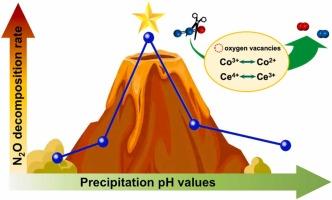沉淀pH与Co-Ce催化剂分解N2O催化性能的火山型变化趋势
IF 6.3
2区 材料科学
Q2 CHEMISTRY, PHYSICAL
引用次数: 0
摘要
氧化亚氮(N2O)的催化分解是减少温室气体排放和减少平流层臭氧消耗的有效可行途径。本文通过调整pH值,采用共沉淀法制备了Co-Ce-X (X=7.0、7.5、8.0、8.5、9.5,指沉淀pH值)复合氧化物催化剂,并对其催化分解N2O的性能进行了评价。有趣的是,可以观察到Co-Ce-X催化剂的催化活性与沉淀pH之间的火山型关系。性能最好的Co-Ce-8.0催化剂在380℃的温度下实现了N2O的完全转化,远低于其他催化剂。Co-Ce-8.0优异的催化性能源于其丰富的氧空位和Co2+含量,两者都有助于N2O的活化、氧的解吸,从而协同促进反应循环。机理研究表明,Co-Ce-8.0催化剂上不良含氮中间体的生成极少,说明吸附在催化剂上的N2O倾向于发生分解反应。此外,Co-Ce-8.0也表现出优异的催化稳定性,在50 h内几乎不会失活。本工作强调了催化剂制备过程中基本参数对催化性能的重要性,为设计其他高效的N2O分解催化剂提供了指导。本文章由计算机程序翻译,如有差异,请以英文原文为准。

Volcano-type trend between precipitation pH and catalytic performance of Co-Ce catalysts towards N2O decomposition
The catalytic decomposition of nitrous oxide (N2O) is an effective and feasible way for mitigating greenhouse gas emissions and reducing stratospheric-ozone-depleting. In this work, Co-Ce-X (X = 7.0, 7.5, 8.0, 8.5, and 9.5, referring to the precipitation pH) composite oxide catalysts were prepared by co-precipitation method by adjusting the pH values and evaluated their catalytic performance for N2O decomposition. Interestingly, the volcano-type relationship between catalytic activity and precipitation pH over Co-Ce-X catalysts can be observed. The best-performing of Co-Ce-8.0 catalyst achieved the full N2O conversion at only 380 °C, which was much lower than that of other catalysts. The superior catalytic performance of Co-Ce-8.0 derived from the abundant oxygen vacancies and Co2+ content, which both contributed to the activation of N2O, the desorption of oxygen species, thereby synergistically promoted the reaction cycle. Mechanism studies showed that the formation of undesirable nitrogen-containing intermediates on Co-Ce-8.0 was minimal, indicating that N2O adsorbed on the catalyst tended to undergo decomposition reactions. Furthermore, Co-Ce-8.0 also exhibited the excellent catalytic stability with almost no deactivation within 50 h. This work emphasized the significance of basic parameters in the process of catalyst preparation on the catalytic performance, and provided guidance for designing other high-efficiency N2O decomposition catalysts.
求助全文
通过发布文献求助,成功后即可免费获取论文全文。
去求助
来源期刊

Journal of Alloys and Compounds
工程技术-材料科学:综合
CiteScore
11.10
自引率
14.50%
发文量
5146
审稿时长
67 days
期刊介绍:
The Journal of Alloys and Compounds is intended to serve as an international medium for the publication of work on solid materials comprising compounds as well as alloys. Its great strength lies in the diversity of discipline which it encompasses, drawing together results from materials science, solid-state chemistry and physics.
 求助内容:
求助内容: 应助结果提醒方式:
应助结果提醒方式:


